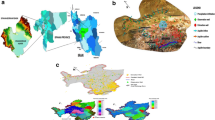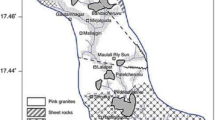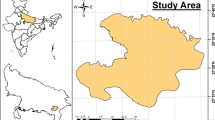Abstract
Groundwater is a precious natural resource. In this densely populated country, most of the areas are facing groundwater scarcity. Now, it is very challenging and also important to evaluate the aquifer and set mitigation, management strategy to provide a safe drinking water demand in this present Holocene time. Tantaria watershed of Bemetara district has been considered as study area because of its down going trend of water table and increasing trend of SO4 concentration in groundwater. To manage and set mitigation strategy for this problem, numerical groundwater modeling software GMS has been used. Water level and water sample have been collected from six different places of the study area and water sample have been tested in laboratory; the concentration of SO4 in three wells (Well No. 2, 3 and 4) are more than the acceptable limit. Hydrological data, empirical values and equations are used for the development of the groundwater transient flow-transport model, water budget estimation and to know the impact of over pumping by the help of MODFLOW & MT3D. The developed model is calibrated by matching computed and observed data with a fair level of accuracy. The study shows that the area is under threat with present rate of water extraction i.e., depletion of water table and rise of SO4 concentration. If this condition will proceed then water table of this area will deplete 2–2.5 m till 2022. So to mitigate this future out coming there is a need to reduce the pumping rate 20% than the present time which is deduced from the study.








Similar content being viewed by others
References
Abu-El-Shar, W. Y., & Hatamleh, R. I. (2007). Using Modflow and MT3D groundwater flow and transport models as a management tool for the azraq groundwater system. Jordan Journal of Civil Engineering, 1, 153–172.
Ahmed, I., & Umar, R. (2009). Groundwater flow modelling of Yamuna-Krishniinterstream, a part of central Ganga Plain Uttar Pradesh. Journal of Earth System Science, 118(5), 507–523.
Akbariyeh, S., Hunt, S. B., Snow, D., Li, X., Tang, Z., & Li, Y. (2018). Three-dimensional modeling of Nitrate-N transport in Vadose Zone: Roles of soil heterogeneity and groundwater flux. Journal of Contaminant Hydrology, 211, 15–25.
Biswas, A., Bhattacharya, P., Mukhherjee, A., Nath, B., Alexanderson, H., Kundu, A. K., Chatterjee, D., & Jacks, G. (2014). Shallow hydrostatigraphy in an arsenic affected region of Bengal basin: implication for targeting safe aquifers for drinking water supply. Journal ofScience of the Total Environment, 485–486, 12–22.
Brown, P. L., Guerin, M., Hankin, S. I., & Lowson, R. T. (1998). Uranium and other contaminant migration in groundwater at a tropical Australian Uranium Mine. Journal of Contaminant Hydrology, 35, 295–303.
CGWB. (2016). Aquifer mapping in Bemetara and Saja blocks, Bemetara district Chhattisgarh. Central Ground Water Board, 22–25(37–39), 62.
CGWB. (2011). Groundwater exploration in Chhattisgarh state, 67–68.
CGWB. (2016–17). Groundwater year book Chhattisgarh, Central Ground Water Board, 7, 82
Ding, F., Yamashita, T., Lee, H. S., & Pan, J. (2014). A modelling study of seawater intrusion in the liao dong bay coastal plain, china. Journal of Marine Science and Technology, 22(2), 103–115.
Elango, L., Brindha, K., Kalpana, L., Sunny, F., Nair, R. N., & Murugan, R. (2012). Groundwater flow and radionuclide decay-chain transport modelling around a proposed uranium tailings pond in India. Hydrogeology Journal, 20, 797–812.
Freeze, R. A. (1971). Three dimensional, transient, saturated-unsaturated flow in a groundwater basin. Water Resources Research., 7(2), 347–366.
Freeze, R. A., & Witerspoon, P. A. (1966). Theoretical analysis of regional groundwater flow:1. Analytical and numerical solution to the mathematical model. Water Resources Research., 2(4), 641–656.
GREC. (1997).Groundwater Resources Estimation Committee report of the groundwater resources estimation methodology. Government of India, New Delhi, 107.
Lee, M. S., Lee, K. K., Hyun, Y., Clement, T. P., & Hamilton, D. (2005). Nitrogen transformation and transport modeling in groundwater aquifers. Journal of Ecological Modelling, 192, 143–159.
McDonald, M.G., & Harbaugh, A.W. (1988). A modular three-dimensional finite-difference ground-water flow model. vol. 6, Chap. A1, U.S. Geological Survey, Techniques of water-resources investigations book.
Rajaveni, S. P., Nair, I. S., & Elango, L. (2016). Evaluation of impact of climate change on seawater intrusion in a coastal aquifer by finite element modelling. Journal of Climate Change, 2, 111–118.
Rejani, R., Jha, M. K., Panda, S. N., & Mull, R. (2007). Simulation modelling for efficient groundwater management in Balasore Coastal Basin. India. Water Resources Management, 22, 23–50.
Rojas, R., & Dassargues, A. (2007). Groundwater flow modelling of the regional aquifer of the Pampa del Tamarugal, northern Chile. Hydrogeology Journal, 15, 537–551.
Sathe, S. S., & Mahanta, C. (2019). Groundwater flow and arsenic contamination transport modeling for a multi aquifer terrain: Assessment and mitigation strategies. Journal of Environmental Management, 213, 166–181.
Senthilkumar, M., & Elango, L. (2004). Three-dimensional mathematical model to simulate groundwater flow in the lower Palar River basin. Southern India. Hydrogeology Journal, 12(4), 197–208.
Toth, J. (1963). A theoretical analysis of groundwater flow in small drainage basin. Journal of Geophysical Research, 68(16), 4795–4812.
Vaidyanadhan, R., & Ramakrishnan, M. (2010). Geology of India. Geological Society of India, 1, 475.
Vetrimurugan, E., Senthilkumar, M., & Elango, L. (2017). Solute transport modelling for assessing the duration of river flow to improve the groundwater quality in an intensively irrigated deltaic region. International Journal of Environmental Science and Technology. https://doi.org/10.1007/s13762-016-1211-0
Wei, X., Bailey, R. T., Records, R. M., Wible, T. C., & Arabi, M. (2018). Comprehensive simulation of nitrate transport in coupled surface subsurface hydrologic systems using the linked SWAT-MODFLOW-RT3D model. Environmental Modelling and Software, 122, 1–33.
Yehia, M. M., Monem, M., Mansour, N. M., & El-Fakharany, M. A. (2013). Using modflow and MT3D groundwater flow and transport models as a management tool for the quaternary aquifer, East Nile Delta Egypt. International Journal of Science Commerce and Humanities, 1, 219–233.
Author information
Authors and Affiliations
Corresponding author
Additional information
Publisher's Note
Springer Nature remains neutral with regard to jurisdictional claims in published maps and institutional affiliations.
Rights and permissions
About this article
Cite this article
Sahu, S.K., Jhariya, D.C. 3D-Mathematical model to simulate groundwater flow and sulfate concentration in Tantaria watershed, Bemetara district, Chhattisgarh, India. Environ Dev Sustain 25, 1667–1683 (2023). https://doi.org/10.1007/s10668-022-02115-x
Received:
Accepted:
Published:
Issue Date:
DOI: https://doi.org/10.1007/s10668-022-02115-x




